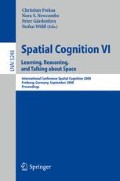Abstract
In “hand assisted” minimally invasive surgery, the surgeon inserts one hand into the operative site. Despite anecdotal claims that seeing their own hand via the laparoscopic camera enhances spatial understanding, a previous study using a maze-drawing task in indirect viewing conditions found that seeing one’s own hand sometimes helped and sometimes hurt performance (Keehner et al., 2004). Here I present a new analysis exploring the mismatch between kinesthetic cues (knowing where the hand is) and visual cues (seeing the hand in an orientation that is incongruent with this). Seeing one’s left hand as if from the right side of egocentric space (palm view) impaired performance, and this depended on spatial ability (r=-.54). Conversely, there was no relationship with spatial ability when viewing the left hand from the left side of egocentric space (back view). The view-specific nature of the confusion raises a possible role for spatial abilities in reconciling spatial frames of reference.
Access this chapter
Tax calculation will be finalised at checkout
Purchases are for personal use only
Preview
Unable to display preview. Download preview PDF.
References
Keehner, M., Wong, D., Tendick, F.: Effects of viewing angle, spatial ability, and sight of own hand on accuracy of movements performed under simulated laparoscopic conditions. In: Proceedings of the Human Factors and Ergonomics Society’s 48th Annual Meeting, pp. 1695–1699 (2004)
Graziano, M.S.A., Gross, C.G.: A bimodal map of space - somatosensory receptive-fields in the macaque putamen with corresponding visual receptive-fields. Experimental Brain Research 97(1), 96–109 (1993)
Driver, J., Spence, C.: Attention and the crossmodal construction of space. Trends in Cognitive Sciences 2, 254–262 (1998)
Penfield, W., Rasmussen, T.L.: The cerebral cortex of man. MacMillan, New York (1955)
Sekiyama, K.: Kinesthetic aspects of mental representations in the identification of left and right hands. Perception and Psychophysics 32, 89–95 (1982)
Funk, M., Brugger, P., Wilkening, F.: Motor processes in children’s imagery: the case of mental rotation of hands. Developmental Science 8(5), 402–408 (2005)
Sekiyama, K., et al.: Body image as a visuomotor transformation device revealed in adaptation to reversed vision. Nature 407, 374–377 (2000)
Graziano, M.S.A.: Where is my arm? Proceedings of the National Academy of Sciences 96, 10418–10421 (1999)
Maravita, A., Spence, C., Driver, J.: Multisensory integration and the body schema: Close to hand and within reach. Current Biology 13, R531–R539 (2003)
Pavani, F., Spence, C., Driver, J.: Visual capture of touch: Out-of-the-body experiences with rubber gloves. Psychological Science 11(5), 353–359 (2000)
Grefkes, C., Fink, G.R.: The functional organization of the intraparietal sulcus in humans and monkeys. Journal of Anatomy 207, 3–17 (2005)
Obayashi, S., Tanaka, M., Iriki, A.: Subjective image of invisible hand coded by monkey intraparietal neurons. Neuroreport. 11(16), 3499–3505 (2000)
Sekiyama, K.: Dynamic spatial cognition: Components, functions, and modifiability of body schema. Japanese Psychological Research 48(3), 141–157 (2006)
Graziano, M.S.A., Cooke, D.F., Taylor, C.S.R.: Coding the location of the arm by sight. Science 290, 1782–1786 (2000)
Cohen, Y.E., Anderson, R.A.: A common reference frame for movement plans in the posterior parietal cortex. Nature Reviews Neuroscience 3, 553–562 (2002)
Colby, C.L.: Action-oriented spatial reference frames in cortex. Neuron. 20, 15–24 (1998)
Maravita, A., et al.: Tool-use changes multimodal spatial interactions between vision and touch in normal humans. Cognition 83, B25–B34 (2002)
Iriki, A., Tanaka, M., Iwamura, Y.: Coding of modified body schema during tool use by macaque postcentral neurones. NeuroReport 7(14), 2325–2330 (1996)
Hegarty, M., Waller, D.: Individual differences in spatial abilities. In: Miyake, A., Shah, P. (eds.) The Cambridge handbook of visuospatial thinking. Cambridge University Press, Cambridge (2005)
Vandenberg, S.G., Kuse, A.R.: Mental rotations, a group test of three-dimensional spatial visualization. Perceptual & Motor Skills 47, 599–604 (1978)
Ekstrom, R.B., et al.: Manual for kit of factor-referenced cognitive tests. Educational Testing Service, Princeton (1976)
Parsons, L.M.: Imagined spatial transformations of one’s hands and feet. Cognitive Psychology 19, 178–241 (1987)
Zacks, J.M., Michelon, P.: Transformations of visuospatial images. Behavioral and Cognitive Neuroscience Reviews 4(2), 96–118 (2005)
Zacks, J.M., Vettel, J.M., Michelon, P.: Imagined viewer and object rotations dissociated with event-related fMRI. Journal of Cognitive Neuroscience 15(7), 1002–1018 (2003)
Carpenter, P.A., et al.: Graded functional activation in the visuospatial system with amount of task demand. Journal of Cognitive Neuroscience 11(1), 9–24 (1999)
Harris, I.M., et al.: Selective right parietal lobe activation during mental rotation. Brain 123, 65–73 (2000)
Podzebenko, K., Egan, G.F., Watson, J.D.G.: Widespread dorsal stream activation during a parametric mental rotation task, revealed with functional magnetic resonance imaging. Neuroimage 15, 547–558 (2002)
Keehner, M., et al.: Modulation of neural activity by angle of rotation during imagined spatial transformations. Neuroimage 33, 391–398 (2006)
Lamm, C., et al.: Differences in the ability to process a visuo-spatial task are reflected in event-related slow cortical potentials of human subjects. Neuroscience Letters 269, 137–140 (1999)
Keehner, M., et al.: Spatial ability, experience, and skill in laparoscopic surgery. American Journal of Surgery 188(1), 71–75 (2004)
Author information
Authors and Affiliations
Editor information
Rights and permissions
Copyright information
© 2008 Springer-Verlag Berlin Heidelberg
About this paper
Cite this paper
Keehner, M. (2008). Conflicting Cues from Vision and Touch Can Impair Spatial Task Performance: Speculations on the Role of Spatial Ability in Reconciling Frames of Reference. In: Freksa, C., Newcombe, N.S., Gärdenfors, P., Wölfl, S. (eds) Spatial Cognition VI. Learning, Reasoning, and Talking about Space. Spatial Cognition 2008. Lecture Notes in Computer Science(), vol 5248. Springer, Berlin, Heidelberg. https://doi.org/10.1007/978-3-540-87601-4_15
Download citation
DOI: https://doi.org/10.1007/978-3-540-87601-4_15
Publisher Name: Springer, Berlin, Heidelberg
Print ISBN: 978-3-540-87600-7
Online ISBN: 978-3-540-87601-4
eBook Packages: Computer ScienceComputer Science (R0)

